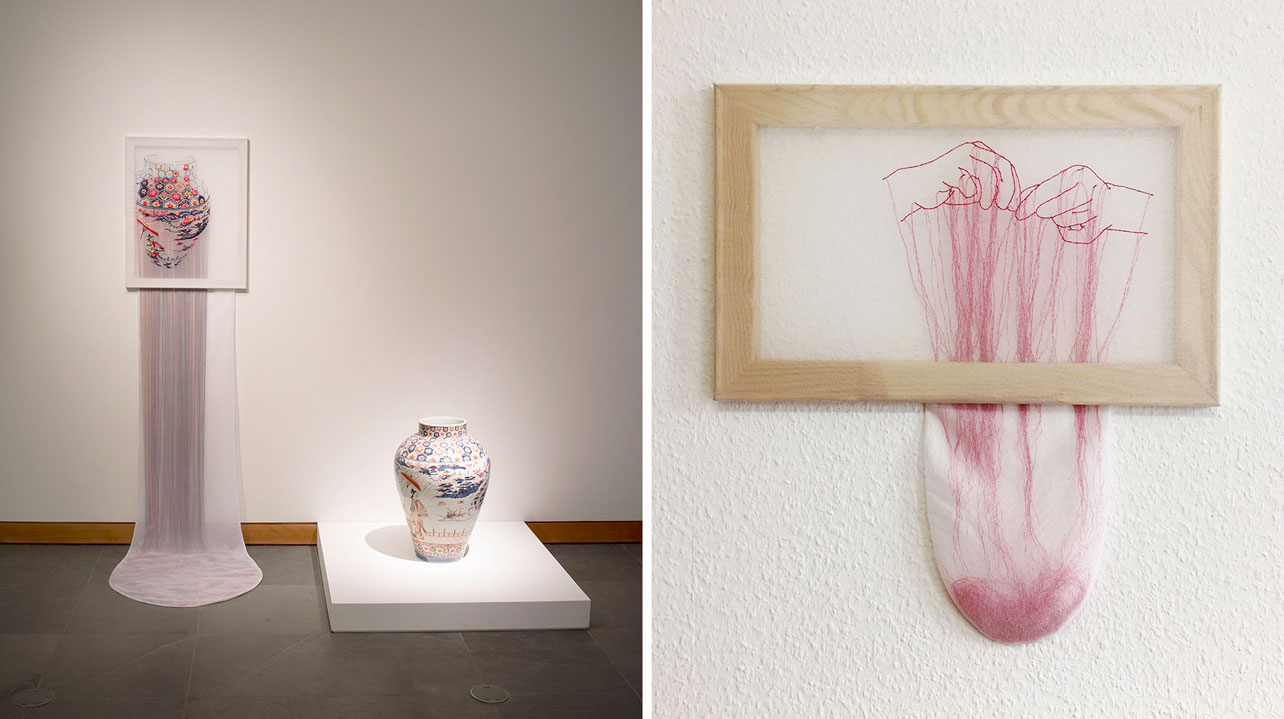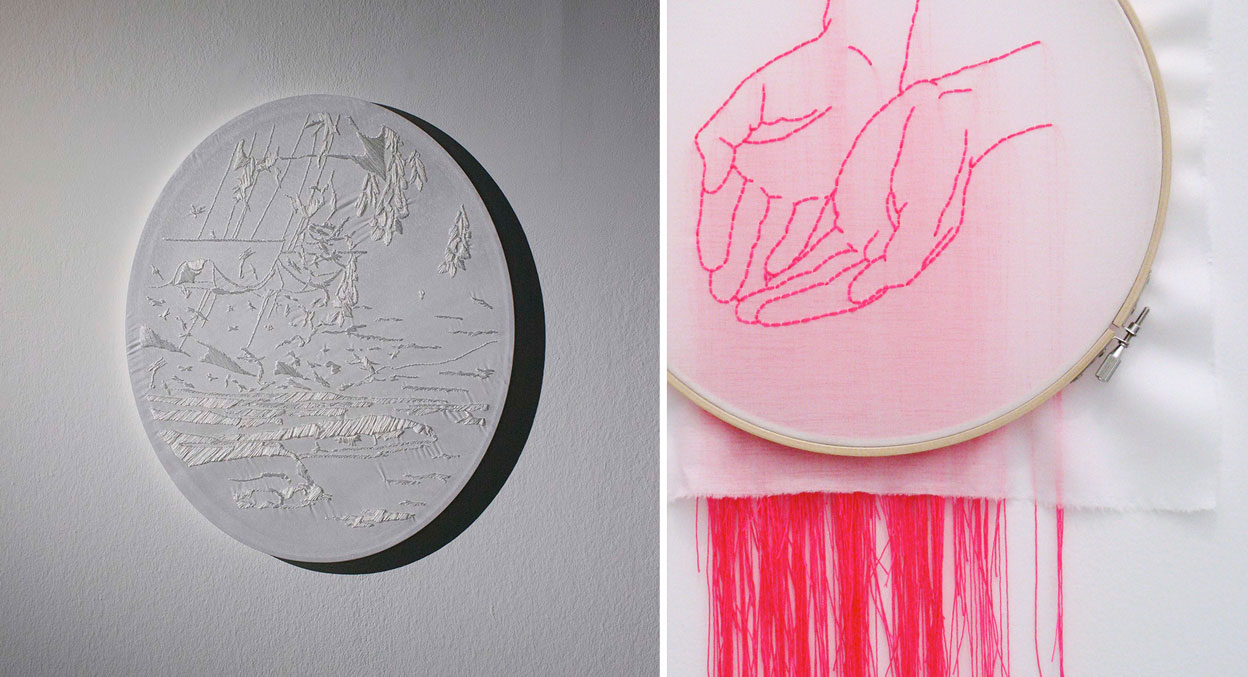ART-TRIBUTE:Weaving and other Practices… Aiko Tezuka
 We continue our Tribute with the Japanese artist Aiko Tezuka (1976- ). Aiko Tezuka carefully unravels and re-weaves elaborate textiles to form new shapes and patterns. In some works, the separated threads hang from the bottom edge of an intact textile in perfectly parallel lines; others feature threads course down in waterfall-like sheaths, reconnecting as they crash into the floor. In still others, the loose threads come together to form images and words hovering on sheer substrates.
We continue our Tribute with the Japanese artist Aiko Tezuka (1976- ). Aiko Tezuka carefully unravels and re-weaves elaborate textiles to form new shapes and patterns. In some works, the separated threads hang from the bottom edge of an intact textile in perfectly parallel lines; others feature threads course down in waterfall-like sheaths, reconnecting as they crash into the floor. In still others, the loose threads come together to form images and words hovering on sheer substrates.
By Efi Michalarou
 Aiko Tezuka was born in 1976 in Tokyo, studied painting in Kyoto and taught in Kyoto and Okayama until 2009. After that she went to London, moved to Berlin in 2011 and received a scholar-ship for the international studio pro-gramme of the Künstlerhaus Bethanien in Berlin in 2012. Aiko Tezuka currently lives and works in Berlin. The textile objects and installations by Aiko Tezuka deal with the history of textiles and discuss it up until today. Thus she buys old fabrics, often in flea markets, but also clothing at huge chains of retail stores and takes them to pieces. By extracting several wefts or respectively warps, the fabrics lose their original form and color, the former patterns are irretrievably destroyed. But the process of deconstruction is always an act of reconstruction: new forms and ornaments evolve, hid-den layers inside the fabric are revealed almost surgically. The disbandment of the fabric into its constituent parts accentuates the impact of the single thread that only attains creative appeal in the network with other threads. The colour also emerges in a new quality: extracted from the mesh, the single tones shine, whereas they appear dulled in the overall context. This effect in the eye of the onlooker and the demonstration of colors being formed by single dots re-spectively lines connect to the concepts of impressionism and pointillism. This shows that Aiko Tezukas works, is mainly influenced by a westward understanding of art and the European art history. This is also an example of globalisa-tion, greatly advancing, beside the cultural communication, especially the economical exchange in the world. It leads to mass production and therefore to a throwaway society and the loss of awareness towards the historical value of textile production, whereas this development is not new in the 20th century. Tezuka combines high and low art and especially accentuates the outlines of these images, showing mostly fabrics with-out the corresponding bodies in their various draperies. The images, embroidered by Tezuka onto the translucent fabric, pick up elements from painting, sculpture and tapestry and reveal close ties between these forms of art. A similar change like the one of the craftsman-ship affected the value of textile fabrics: Once a sign for wealth, today anyone can buy clothes anywhere. Therefore Aiko Tezuka is also interested in aspects like: what is the meaning of fabric and clothing to their owner and wearer? Which changes do they cause? Which individual stories are behind a piece of fabric?
Aiko Tezuka was born in 1976 in Tokyo, studied painting in Kyoto and taught in Kyoto and Okayama until 2009. After that she went to London, moved to Berlin in 2011 and received a scholar-ship for the international studio pro-gramme of the Künstlerhaus Bethanien in Berlin in 2012. Aiko Tezuka currently lives and works in Berlin. The textile objects and installations by Aiko Tezuka deal with the history of textiles and discuss it up until today. Thus she buys old fabrics, often in flea markets, but also clothing at huge chains of retail stores and takes them to pieces. By extracting several wefts or respectively warps, the fabrics lose their original form and color, the former patterns are irretrievably destroyed. But the process of deconstruction is always an act of reconstruction: new forms and ornaments evolve, hid-den layers inside the fabric are revealed almost surgically. The disbandment of the fabric into its constituent parts accentuates the impact of the single thread that only attains creative appeal in the network with other threads. The colour also emerges in a new quality: extracted from the mesh, the single tones shine, whereas they appear dulled in the overall context. This effect in the eye of the onlooker and the demonstration of colors being formed by single dots re-spectively lines connect to the concepts of impressionism and pointillism. This shows that Aiko Tezukas works, is mainly influenced by a westward understanding of art and the European art history. This is also an example of globalisa-tion, greatly advancing, beside the cultural communication, especially the economical exchange in the world. It leads to mass production and therefore to a throwaway society and the loss of awareness towards the historical value of textile production, whereas this development is not new in the 20th century. Tezuka combines high and low art and especially accentuates the outlines of these images, showing mostly fabrics with-out the corresponding bodies in their various draperies. The images, embroidered by Tezuka onto the translucent fabric, pick up elements from painting, sculpture and tapestry and reveal close ties between these forms of art. A similar change like the one of the craftsman-ship affected the value of textile fabrics: Once a sign for wealth, today anyone can buy clothes anywhere. Therefore Aiko Tezuka is also interested in aspects like: what is the meaning of fabric and clothing to their owner and wearer? Which changes do they cause? Which individual stories are behind a piece of fabric?


















